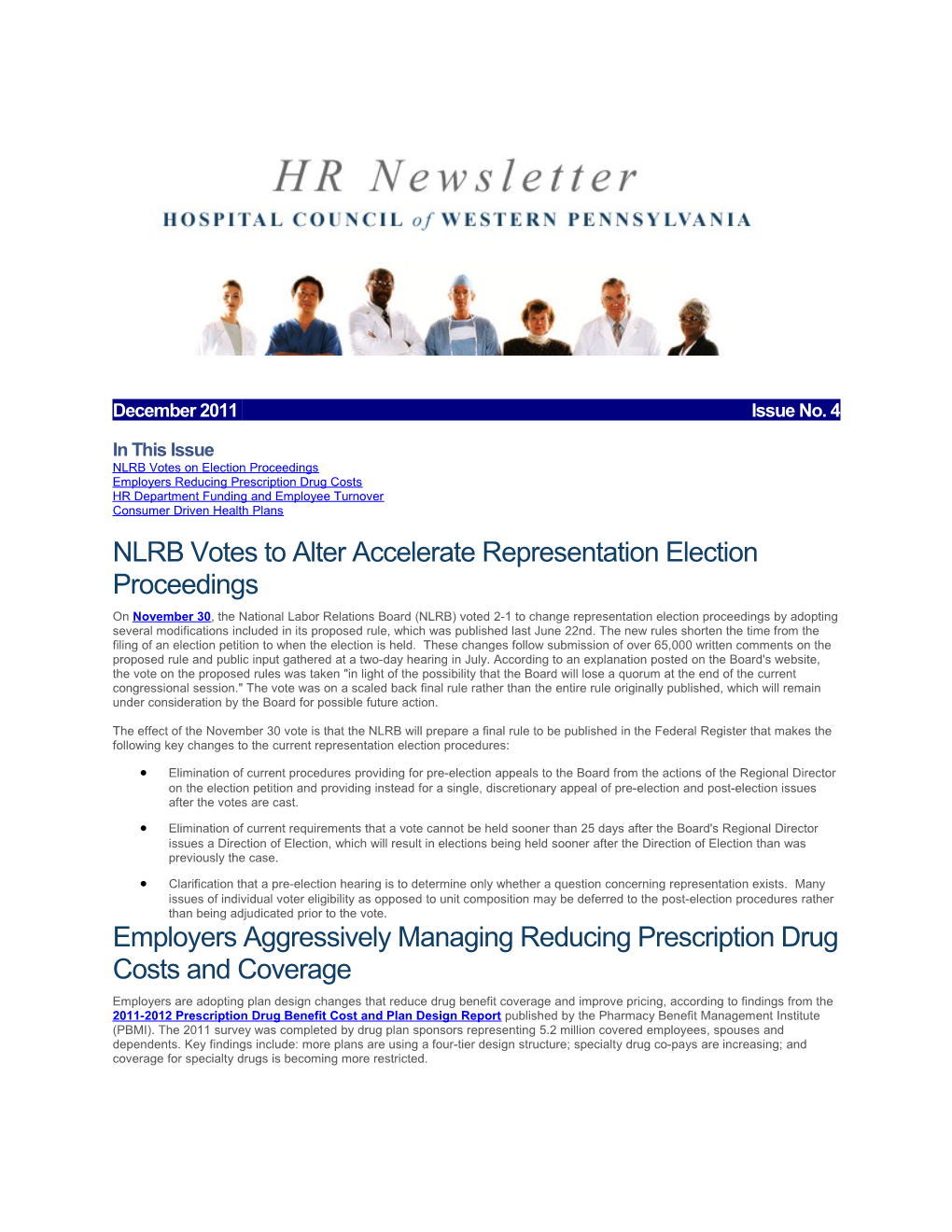December 2011Issue No. 4
In This Issue
NLRB Votes on Election Proceedings
Employers Reducing Prescription Drug Costs
HR Department Funding and Employee Turnover
Consumer Driven Health Plans
NLRB Votes to Alter Accelerate Representation Election Proceedings
On November 30, the National Labor Relations Board (NLRB) voted 2-1 to change representation election proceedings by adopting several modifications included in its proposed rule, which was published last June 22nd. The new rules shorten the time from the filing of an election petition to when the election is held. These changes follow submission of over 65,000 written comments on the proposed rule and public input gathered at a two-day hearing in July. According to an explanation posted on the Board's website, the vote on the proposed rules was taken "in light of the possibility that the Board will lose a quorum at the end of the current congressional session." The vote was on a scaled back final rule rather than the entire rule originally published, which will remain under consideration by the Board for possible future action.
The effect of the November 30 vote is that the NLRB will prepare a final rule to be published in the Federal Register that makes the following key changes to the current representation election procedures:
- Elimination of current procedures providing for pre-election appeals to the Board from the actions of the Regional Director on the election petition and providing instead for a single, discretionary appeal of pre-election and post-election issues after the votes are cast.
- Elimination of current requirements that a vote cannot be held sooner than 25 days after the Board's Regional Director issues a Direction of Election, which will result in elections being held sooner after the Direction of Election than was previously the case.
- Clarification that a pre-election hearing is to determine only whether a question concerning representation exists. Many issues of individual voter eligibility as opposed to unit composition may be deferred to the post-election procedures rather than being adjudicated prior to the vote.
Employers Aggressively Managing Reducing Prescription Drug Costs and Coverage
Employers are adopting plan design changes that reduce drug benefit coverage and improve pricing, according to findings from the 2011-2012 Prescription Drug Benefit Cost and Plan Design Report published by the Pharmacy Benefit Management Institute (PBMI). The 2011 survey was completed by drug plan sponsors representing 5.2 million covered employees, spouses and dependents. Key findings include: more plans are using a four-tier design structure; specialty drug co-pays are increasing; and coverage for specialty drugs is becoming more restricted.
Is There a Connection Between Human Resource Department Funding and Employee Turnover?
According to the 2011-2012 U.S. Human Capital Effectiveness Report published by Pricewaterhouse Coopers Saratoga, annual employee turnover, voluntary and involuntary, at the 50 hospitals represented in the report stood at 26.2 percent in 2010. That compares to an overall average of 22.7 percent for all industries. The report also notes that average annual human resource department spending in hospitals was $701 per employee in 2010 compared to an all-industry average of $1,495. Furthermore, there were 148 employees for every human resource staff member in hospitals compared to an all-industry average of 91 employees for every human resource staff member.
Steady Growth in Enrollment in Consumer Driven Health Plans
Enrollment in consumer-driven health plans (CDHPs) continued to grow in 2011, according to the 11th Annual Consumer Engagement in Health Care Survey. In 2011, 7 percent of the U.S. adult population was enrolled in a CDHP, through a group plan or individual policy, compared with 5 percent in 2010 and only 1 percent in 2006. The survey of over 4,700 privately insured adults ages 21-64 was sponsored by the Employee Benefit Research Institute (EBRI) and Mathew Greenwald & Associates (MGA). CDHPs combine a high-deductible health plan with an HSA or HRA. According to the report, another 16 percent of adults are covered by a CDHP that does not include an HSA or HRA.
Hospital Council of Western Pennsylvania
Hospital Council of Western Pennsylvania is a strategic partner with western Pennsylvania health care providers and affiliated organizations, enabling them to realize their missions while maintaining their status as economically viable entities.
Visit
Call 1-800-704-8434
